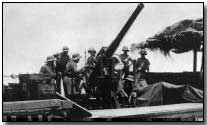Battles - Capture of Tikrit, 1917
 Forming the final notable
action presided over by regional British Commander-in-Chief
Sir Frederick
Stanley Maude - he died of cholera on 18 November (rather than as a result
of poisoning, as believed by many) - the Capture of Tikrit was also one of the
final significant engagements fought on the Mesopotamian Front.
Forming the final notable
action presided over by regional British Commander-in-Chief
Sir Frederick
Stanley Maude - he died of cholera on 18 November (rather than as a result
of poisoning, as believed by many) - the Capture of Tikrit was also one of the
final significant engagements fought on the Mesopotamian Front.
It was fought in the wake of the decisive combined Anglo-Indian success at the Battle of Ramadi in September 1917. Maude despatched General Alexander Cobbe at the head of two divisions further up the River Tigris to tackle newly-established Turkish defensive positions some 13km north of Samarrah (itself taken during the year's earlier Spring offensive).
However before Cobbe could strike local Turkish commander Ismail Hakki Bey received news of the advance and made haste to withdraw his position to a position directly in front of the town of Tikrit. There, heavily protected Turkish trenches defended the town - built on cliffs over the river - in a ring on the west bank of the River Tigris.
Cobbe nevertheless attacked Hakki's lines on 5 November 1917, having been reinforced by a division of cavalry in the interim. Frontal attacks succeeded after three hours fighting in taking the Turkish front line, although heavy British cavalry losses were incurred during a charge on the Turkish second lines.
Ultimately the Turks chose to withdraw, under skilful cover, further upstream to Fathah Gorge. Consequently Cobbe took possession of the town on 6 November but found it stripped of both men and supplies.
The sudden death of Maude twelve days later brought a halt to British operations, particularly those aimed at seizing control of regional oilfields, although his successor as Commander-in-Chief, Sir William Marshall, continued with Maude's cautious offensive strategy.
Sir William Robertson - Chief of the Imperial General Staff in London - took the opportunity however to scale back operations on the Mesopotamian Front, a policy he felt unable to execute while Maude demonstrated continuing success in the region.
Click here to view a map charting operations at the time of the fall of Baghdad.
Photograph courtesy of Photos of the Great War website
A "creeping barrage" is an artillery bombardment in which a 'curtain' of artillery fire moves toward the enemy ahead of the advancing troops and at the same speed as the troops.
- Did you know?
